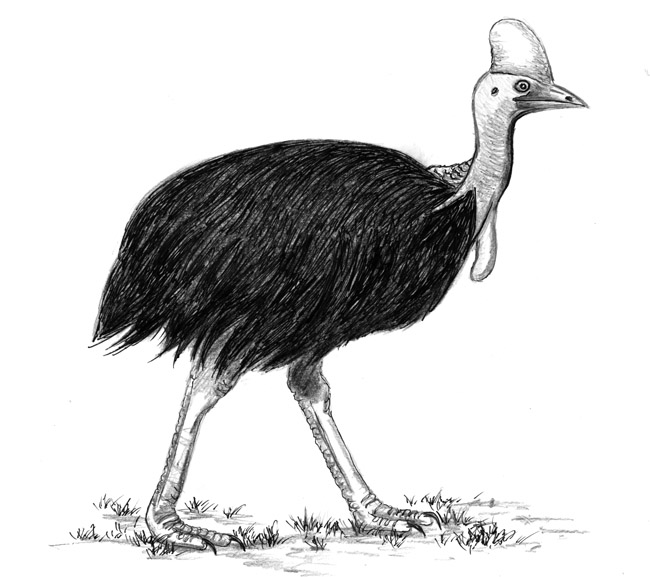
Dear Bird Folks,
I was reading a list of the world’s most dangerous creatures, which included crocodiles, sharks and snakes, but I was surprised to see an Australian bird called a “cassowary” on the list. I’m going to Australia next month. Should I be worried?
– Deirdre, Sandusky, OH
It’s silly, Deirdre,
I too have seen lists that include cassowaries as one of the world’s most dangerous creatures. Are they kidding? It’s a bird! The list of dangerous things should begin and end with snakes, and that’s all. Having birds on the same list as snakes is like having a banana split and ice milk on the same menu. Technically, they are both desserts, but one is delicious, while the other tastes like something scraped off the bottom of a Zamboni. I’m not sure if that analogy makes any sense, but after all the heat this summer, ice cream is the only thing I’ve had on my mind, so I’m going with it.
If asked to make a list (speaking of lists) of flightless birds, most people would include penguins, ostriches and perhaps kiwis. I doubt anyone would mention cassowaries, probably because most folks have never heard of them. Cassowaries are secretive loners that spend their lives hidden in the forests and jungles of northern Australia and New Guinea. Standing nearly six feet tall and weighing as much as 120 pounds, cassowaries are the second heaviest bird in the world and are totally freaky looking. They have the body of an ostrich, the colorful neck of a turkey and the head of dinosaur, complete with a weird horn thing growing out of the top of the skull. In fact, the name, cassowary, is derived from a native term meaning “horn head,” and it fits the bird perfectly. Scientists have debated about the purpose of this horn but can’t seem to come to an agreement. Some think the horn protects the birds as they plow through the jungle, while others believe the horn somehow helps their loud call resonate. Still, other researchers feel the horn is a status symbol that may be an important factor in mating; hence, the origin of the word “horny.”
Officially, cassowaries are classified as omnivores, but most of their diet consists of fruit, lots and lots of fruit. So how can a fruit-eating bird be considered dangerous? Well, what I didn’t mention in my earlier description of cassowaries is their feet. Each foot has three huge toes; on the end of these toes are three sharp, extremely long toenails, making the bird Australia’s answer to Howard Hughes. In addition, cassowaries have extremely powerful legs. They can run in excess of thirty MPH and can leap long distances. The combination of long claws and super-strong legs, definitely gives these birds lethal weapons. So what does a fruit-loving bird need with such weapons? Well, don’t forget these birds are flightless and susceptible to attacks from Australian snakes, dingoes, snakes and the ever-dangerous roving gangs of punk koalas. But what cassowaries worry about the most about are other cassowaries. These birds really don’t like each other. The males are constantly grumpy and ready to do battle with each other whenever they meet.
A lone cassowary patrols a large territory and will quickly defend it from other intruding cassowaries. Usually, a little strutting and growling will keep the invader away, but if that doesn’t work, a fight will break out. The birds will launch at each other with both feet, slashing with those long, sharp claws. At some point, when there’s a break in the action, a female may wander into a territory, mate with the resident male, lay her eggs and then wander out again. The female will then seek to mate with another male, while the previous male is left to incubate the female’s eggs by himself and raise the chicks all alone. (No wonder they’re always grumpy.)
In addition to its huge size and impressive ability to defend itself, cassowaries have another, rather strange feature that separates it from all other birds. When upset, they give off a deep roar that sounds like the MGM lion. They also can produce an even deeper call that is barely audible to the human ear. This sound is considered to be the deepest call produced by any bird in the world, making the cassowary Australia’s answer to Barry White.
Now that we have established that cassowaries are ginormous birds, with powerful feet and scary, deep voices, it’s easy to understand why they have made the list of the world’s most dangerous creatures. And yes, they can be nasty when protecting their young or if threatened. There have been a number of skirmishes with people who have offered the birds food for some reason. But it appears this bird’s deadly reputation is a bit overestimated, except for one event that took place back in 1926. It seems an Aussie teenager decided it would be fun to assault a cassowary with a club. (Things didn’t turn out so well for the teen.) From then on, all of the other cassowaries have been guilty by association.
Have a great trip to Australia, Deirdre. I wouldn’t worry too much about being attacked by cassowaries. They pretty much go out of their way to avoid people. I’d be more worried about the crocs and the snakes, especially the snakes, and of course those roving gangs of punk koalas. There’s nothing you can do to save yourself from them.